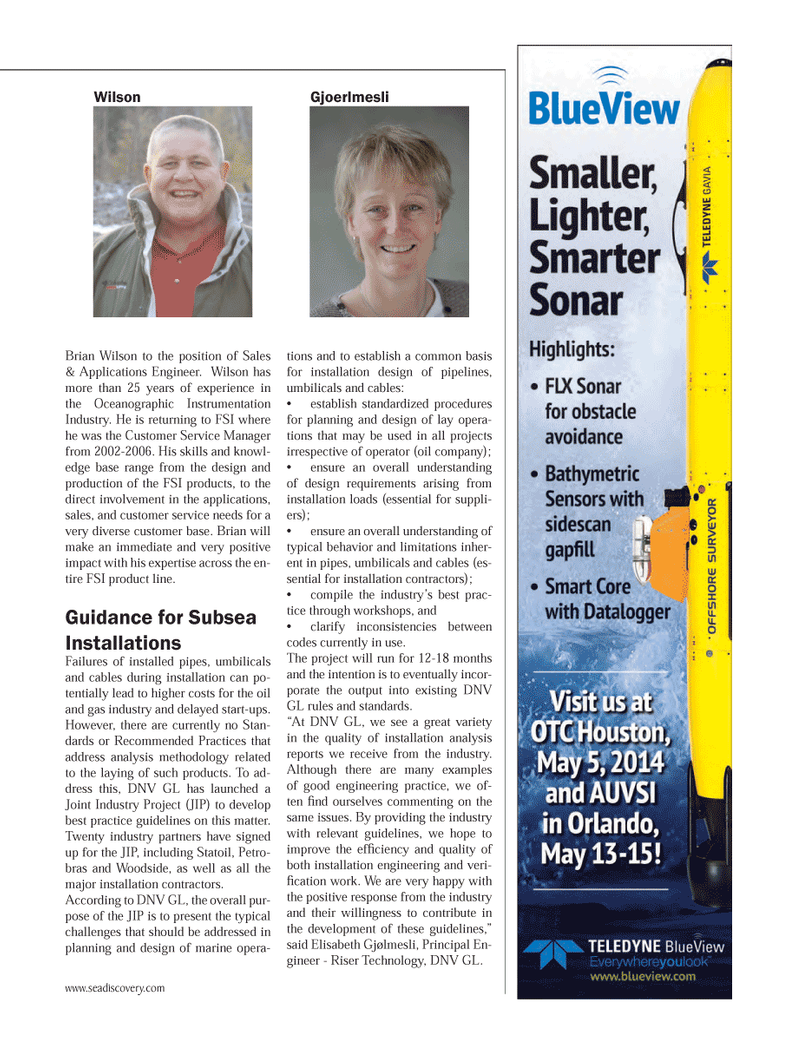
Page 47: of Marine Technology Magazine (April 2014)
Offshore Energy
Read this page in Pdf, Flash or Html5 edition of April 2014 Marine Technology Magazine
Brian Wilson to the position of Sales & Applications Engineer. Wilson has more than 25 years of experience in the Oceanographic Instrumentation
Industry. He is returning to FSI where he was the Customer Service Manager from 2002-2006. His skills and knowl- edge base range from the design and production of the FSI products, to the direct involvement in the applications, sales, and customer service needs for a very diverse customer base. Brian will make an immediate and very positive impact with his expertise across the en- tire FSI product line.
Guidance for Subsea
Installations
Failures of installed pipes, umbilicals and cables during installation can po- tentially lead to higher costs for the oil and gas industry and delayed start-ups.
However, there are currently no Stan- dards or Recommended Practices that address analysis methodology related to the laying of such products. To ad- dress this, DNV GL has launched a
Joint Industry Project (JIP) to develop best practice guidelines on this matter.
Twenty industry partners have signed up for the JIP, including Statoil, Petro- bras and Woodside, as well as all the major installation contractors.
According to DNV GL, the overall pur- pose of the JIP is to present the typical challenges that should be addressed in planning and design of marine opera- tions and to establish a common basis for installation design of pipelines, umbilicals and cables: establish standardized procedures for planning and design of lay opera- tions that may be used in all projects irrespective of operator (oil company); ensure an overall understanding of design requirements arising from installation loads (essential for suppli- ers); ensure an overall understanding of typical behavior and limitations inher- ent in pipes, umbilicals and cables (es- sential for installation contractors); compile the industry’s best prac- tice through workshops, and clarify inconsistencies between codes currently in use.
The project will run for 12-18 months and the intention is to eventually incor- porate the output into existing DNV
GL rules and standards. “At DNV GL, we see a great variety in the quality of installation analysis reports we receive from the industry.
Although there are many examples of good engineering practice, we of- ten fi nd ourselves commenting on the same issues. By providing the industry with relevant guidelines, we hope to improve the effi ciency and quality of both installation engineering and veri- fi cation work. We are very happy with the positive response from the industry and their willingness to contribute in the development of these guidelines,” said Elisabeth Gjølmesli, Principal En- gineer - Riser Technology, DNV GL.
Wilson Gjoerlmesli www.seadiscovery.com
MTR #3 (34-49).indd 47 4/10/2014 9:00:51 AM

 46
46

 48
48
